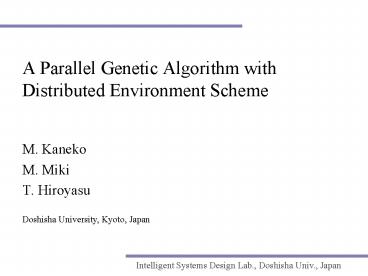A Parallel Genetic Algorithm with Distributed Environment Scheme - PowerPoint PPT Presentation
1 / 15
Title:
A Parallel Genetic Algorithm with Distributed Environment Scheme
Description:
The performance of GAs depends on a choice for the rates of parameters. ... Epistasis. Rastrigin. Schwefel. Griewank. Rosenbrlck. Intelligent Systems Design Lab. ... – PowerPoint PPT presentation
Number of Views:98
Avg rating:3.0/5.0
Title: A Parallel Genetic Algorithm with Distributed Environment Scheme
1
A Parallel Genetic Algorithm withDistributed
Environment Scheme
- M. Kaneko
- M. Miki
- T. Hiroyasu
Doshisha University, Kyoto, Japan
2
Background
- GAs(Genetic Algorithms)
- Stochastic search algorithms based on the
mechanics of natural selection and natural
genetics - Disadvantage
- A huge amount of computational resource is
required. - The performance of GAs depends on a choice for
the rates of parameters. However, it is difficult
to choose proper rates of parameters.
Parallel Distributed GA (PDGA)
PDGA with Distributed Environment
3
Parallel Distributed GA
Single Population GA (SPGA)
Parallel Distributed GA (PDGA)
Subpopulation
Population
Migration
Individual
- Some GAs are performed in multiple
subpopulations. - Migration Exchange of individuals among
subpopulations
4
Crossover and Mutation
- Crossover
- To perform direct information exchange between
individuals - Mutation
- To avoid stagnation in evolution
0.6 DeJong (1975) 0.95 Grefenstette
(1986) 0.750.95 Bäck (1996)
child A
child B
0.001 DeJong (1975) 0.01 Grefenstette
(1986) 0.0050.01 Schaffer (1989) 1/L
Bäck (1996) L Coromosome Length
5
Test Functions
Name
Functions
Chromosome length (bit)
Epistasis
Rastrigin
100 (10bits10variables)
none
none
Schwefel
100 (10bits10variables)
100 (10bits10variables)
Griewank
weak
120 (12bits10variables)
strong
Rosenbrock
Rastrigin
Schwefel
Griewank
Rosenbrlck
6
Procedures of Experiments
Mutation Rate
9 20, 180 180,1620 20 0.3 1000
Number of Subpopulations Subpopulation size Total
Population size Migration Interval Migration
Rate Max Generations
0.1/L
1/L
10/L
0.3
0.1/L
1/L
10/L
0.3
0.3
0.3
0.6
0.1/L
1/L
10/L
Crossover Rate
Roulette selection Conservation of elite One
point crossover The average of 10 trials out of
12 trials omitting the highest and lowest values
0.6
0.6
0.6
1.0
0.1/L
1/L
1.0
1.0
LChromosome length
nCUBE2 with 64 processors Processor network
Hypercube One processor is assigned to one
subpopulation.
7
History of Fitness (SPGA)
Rastrigin Pop. Size 180
Fitness value
Pm 0.1/L
Pm 1/L
Pm 10/L
8
The Effect of Crossover and Mutation Rates
(SPGA)
Pc - Pm
9
History of Fitness (PDGA)
Rastrigin Pop. Size 180
Fitness value
Pm 0.1/L
Pm 1/L
Pm 10/L
10
The Effect of Crossover and Mutation Rates
(PDGA)
11
Comparison of the performance
(SPGA and PDGA)
Pop. Size 180
12
PDGA/DE (Distributed Environment)
PDGA/DE (Distributed Environment)
Different crossover rates Different mutation rates
PDGA/CE (Constant Environment)
A Constant crossover rate A Constant mutation rate
Mutation rate
Crossover rate
13
Effectiveness of PDGA/DE
Pop. Size 180
14
Speedup
PDGA/DE vs. SPGA (with the best combination)
Ideal speedup
(1) 8.6 (similar to the ideal speedup) (2)
between 22 and 25 (except for the Rosenbrock
function) PDGA/DE provides solution 2.6 to
2.9 times faster than SPGA
15
Conclusions
- The optimum crossover and mutation rates vary
according to the population size and the problem
to be solved. - A parallel distributed GA with distributed
environment(PDGA/DE) is proposed, and the
superiority of this scheme is experimentally
proved. - PDGA/DE is the fastest way to gain the best
solution under uncertainty of the appropriate
crossover and mutation rates.































